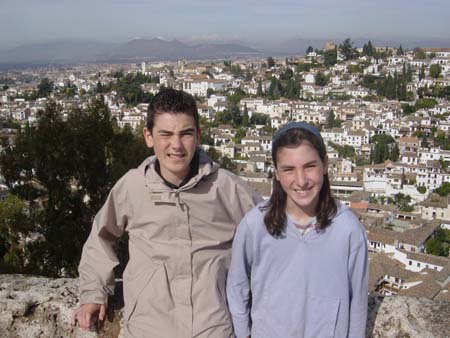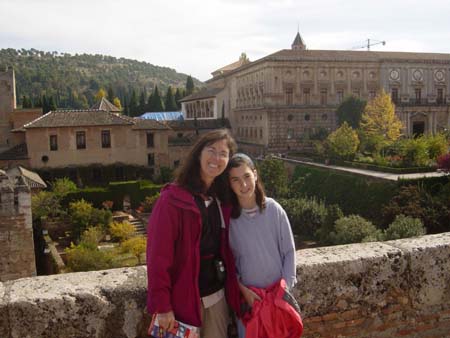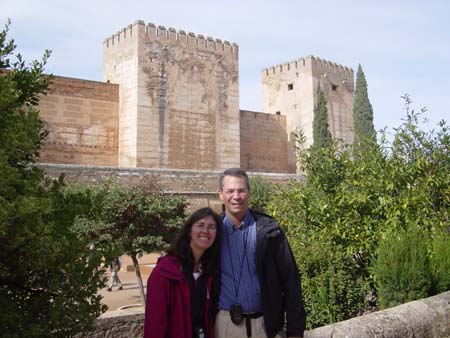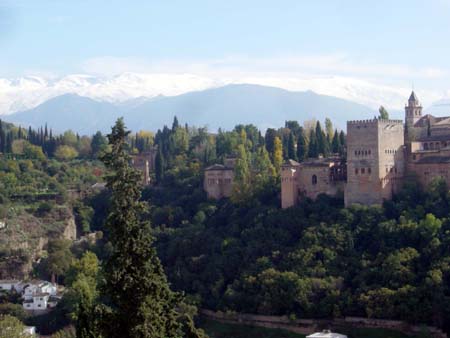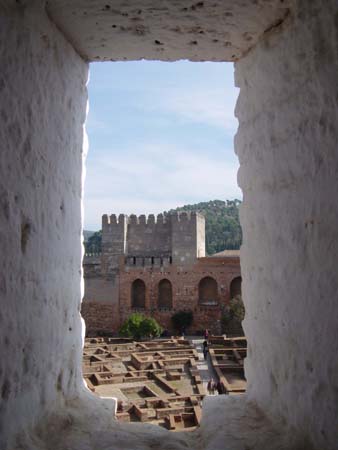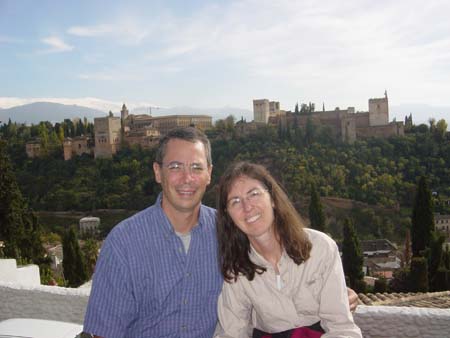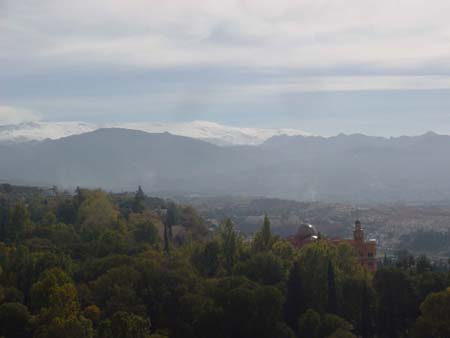Sunday, November 2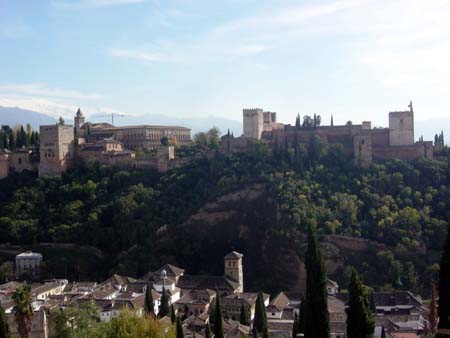
Paula: Our priority today was to visit the Alhambra, the fortress and palace of the Nasrid sultans who controlled Granada for hundreds of years. This site is so popular that it's necessary to reserve tickets (with a specific entry time) in advance. The site includes a number of palaces, gardens, and a military area called the Alcazaba, as well as the remains of an old medina all within the fortress walls. The Moorish architectural style was similar to what we have seen in Morocco and Seville. What distinguished the Alhambra for us is its spectacular location and surroundings. The palace is set high above the city with the snow topped Sierra Nevada Mountains in the background - it's a remarkable image that will stay in our minds.
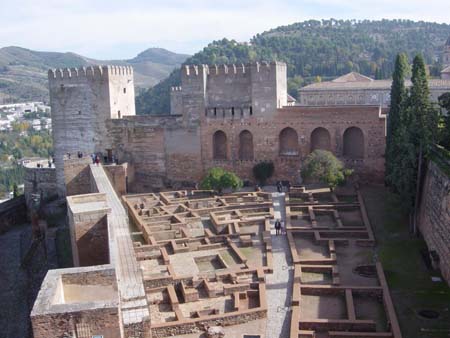
The original palace was built in the 11th century atop an old fortress. Additional
palaces were built during the 13th and 14th 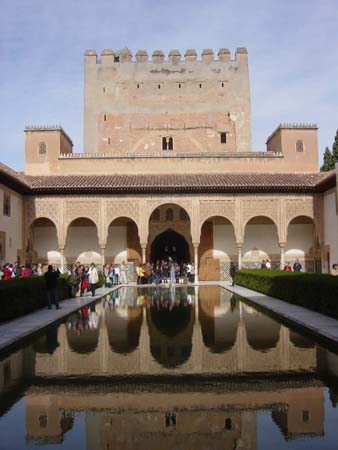 century,
the most elaborate being the Palacio Nazaries. In addition, a huge Renaissance
palace, Palaciode Carlos V, was built here after the Christian Reconquista.
century,
the most elaborate being the Palacio Nazaries. In addition, a huge Renaissance
palace, Palaciode Carlos V, was built here after the Christian Reconquista.
The combination of carved marbleized plaster, tile and carved wood ceilings
within the Palacio Nazaries is striking. I find the layout of Moorish architecture
particularly relaxing. The combination of rooms surrounding an open courtyard
and the use of gentle fountains and reflection pools is extremely tranquil.
The Muslims are particularly fond of water and even most homes have hammams
(baths) and fountains. Like the fountains we saw in Peterhof Palace (St. Pete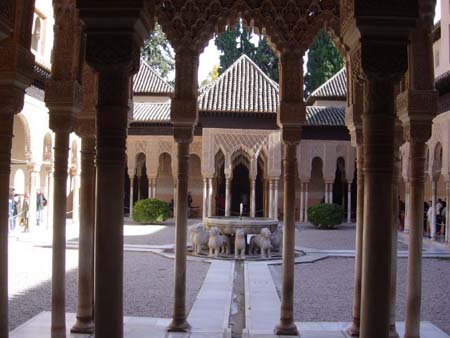 rsburg),
the fountains were designed to run by gravity. Throughout the Alhambra, we
saw water running from one walkway to another, to and from buildings and ponds.
The use of fountains and water in Alhambra, however has a very different intent
than in Peterhof. In Peterhof the fountains were large and active while the
fountains of the Alhambra were elegant and calm. My favorite was a large marble
shallow bowl set on a pedestal with water gently overflowing from the dish.
rsburg),
the fountains were designed to run by gravity. Throughout the Alhambra, we
saw water running from one walkway to another, to and from buildings and ponds.
The use of fountains and water in Alhambra, however has a very different intent
than in Peterhof. In Peterhof the fountains were large and active while the
fountains of the Alhambra were elegant and calm. My favorite was a large marble
shallow bowl set on a pedestal with water gently overflowing from the dish.
The views from the watchtower and fortress wall were also lovely. From here we could see the surrounding Albayzin quarter (old Islamic quarter), the city of Granada and its cathedral, and surrounding snow-capped Sierra Nevada Mountains. These views gave us a wonderful appreciation for the overall beauty of this area.
After leaving the Alhambra, we ventured into the Albayzin quarters and Mirador
San Nicolas, a spirited plaza on a hillside opposite the Alhambra. Here, in
addition to the spectacular views, we discovered a lively group of students
and gypsies drinking, si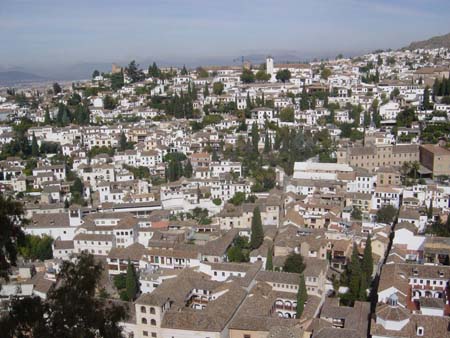 nging
and dancing to guitar and bongos. The Albayzin is a labyrinth of narrow streets
and homes that retain their Moorish roots, but now have become a popular residence
for international students who live in Granada. We wandered through the narrow
cobblestone streets to a
nging
and dancing to guitar and bongos. The Albayzin is a labyrinth of narrow streets
and homes that retain their Moorish roots, but now have become a popular residence
for international students who live in Granada. We wandered through the narrow
cobblestone streets to a 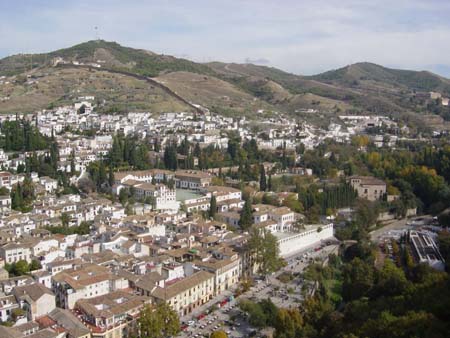 restaurant
called El Agua. This small restaurant had a nice view of the Albayzin and
wonderful fondue. We left content after feasting on cheese, meat and chocolate
fondue. While still in the Albayzin, we strolled down Caldarella Nueva. This
street was crowded with young people and shops selling Moorish handicrafts.
The restaurants and cafes on this street all specialized in Moroccan food
and were crowded and lively.
restaurant
called El Agua. This small restaurant had a nice view of the Albayzin and
wonderful fondue. We left content after feasting on cheese, meat and chocolate
fondue. While still in the Albayzin, we strolled down Caldarella Nueva. This
street was crowded with young people and shops selling Moorish handicrafts.
The restaurants and cafes on this street all specialized in Moroccan food
and were crowded and lively. 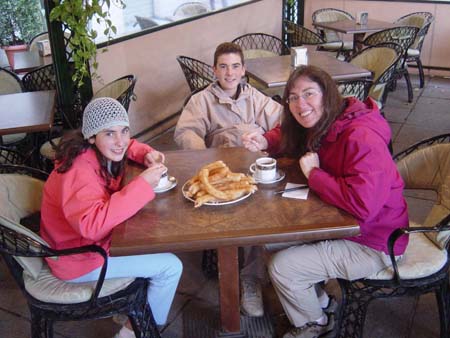
Before completing our day, we decided to walk down to explore the waterfront along the Rio Darro which runs through Granda. We discovered a Churreria which specializes in Spanish chocolate and churros. We had heard that this was a must try Spanish treat. Churros are long pieces of fried dough that are served with "hot chocolate." To our delight, Spanish style hot chocolate tastes like warm chocolate pudding! The waterfront was nice but the river quite low, probably a lingering result from the summer's drought.
Tomorrow we're driving to Cordoba, our last stop in Andalucia.
Distance Walked: 2.38 miles
